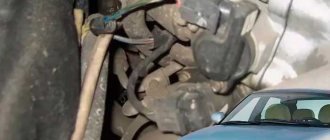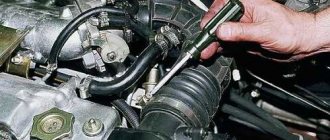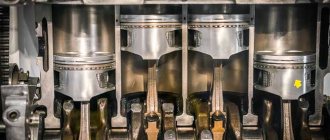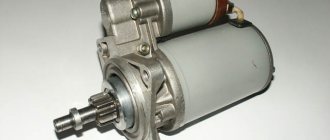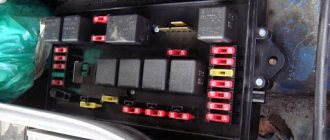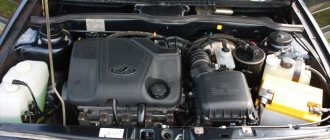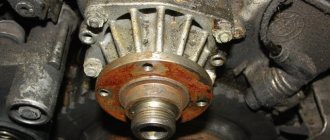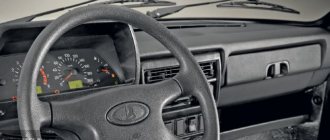The car stalled on the road and won't start.
- Thank you
- I do not like
Evgeniy_K July 26, 2008
Hello everyone, it's me again.
VAZ 2110 '05 1.6i 8cl. 40 thousand km
I was driving home, the gas light was on, I filled it up for 500 rubles at my trusted gas station, I drove off, after a couple of kilometers on a turn while switching to second - it stalled, I turned the ignition key - it started, stuck the second one in (because it was still rolling by inertia), clutch, grabbed let's move on. after a couple of kilometers the same garbage. I pulled the ignition, released the clutch, grabbed it in gear, and drove off. And finally, for the third time, it stalled while driving when the clutch pedal was pressed and would not start again. All the way, without straining, the temperature stayed at 90. The starter turns, and when the starter is running, the oil pressure light and the check engine light go out. The engine won't start. Neither with the gas pedal to the floor, nor as usual. I disconnected the terminal from the battery for 15 minutes, it didn’t help. There, in the field, they checked what they could: all the fluids are in place, there is gasoline in the ramp, there is pressure on the eye, the fuel pump turns and delivers gasoline when the ignition is turned on, the fuel pump relay clicks properly, there is a spark on the turned-out spark plug, but the spark plug is dry, like teeth from a hangover. and this after several attempts to start. Gasoline was drained from the ramp to visually check for impurities. The gasoline looks normal, homogeneous, no water is visible. After 20 minutes of stupidly listening to music and waiting for a friend with a tie, I reacted positively to the next attempt to start, grabbed it and worked for a minute, revved it up, the speed was picking up, but I don’t like the sound of the engine, it’s not native. It stalled on its own and would not start again. They dragged it to the parking lot. Have your brains gone missing? I don’t understand at all.
Tell me, maybe someone had something similar, huh?
Z.Y. I wiped the headlights and knocked on the wheel, it doesn’t help.
- Thank you
- I do not like
Caesar July 27, 2008
Hello everyone, it's me again.
VAZ 2110 '05 1.6i 8cl. 40 thousand km
I was driving home, the gas light was on, I filled it up for 500 rubles at my trusted gas station, I drove off, after a couple of kilometers on a turn while switching to second - it stalled, I turned the ignition key - it started, stuck the second one in (because it was still rolling by inertia), clutch, grabbed let's move on. after a couple of kilometers the same garbage. I pulled the ignition, released the clutch, grabbed it in gear, and drove off. And finally, for the third time, it stalled while driving when the clutch pedal was pressed and would not start again. All the way, without straining, the temperature stayed at 90. The starter turns, and when the starter is running, the oil pressure light and the check engine light go out. The engine won't start. Neither with the gas pedal to the floor, nor as usual. I disconnected the terminal from the battery for 15 minutes, it didn’t help. There, in the field, they checked what they could: all the fluids are in place, there is gasoline in the ramp, there is pressure on the eye, the fuel pump turns and delivers gasoline when the ignition is turned on, the fuel pump relay clicks properly, there is a spark on the turned-out spark plug, but the spark plug is dry, like teeth from a hangover. and this after several attempts to start. Gasoline was drained from the ramp to visually check for impurities. The gasoline looks normal, homogeneous, no water is visible. After 20 minutes of stupidly listening to music and waiting for a friend with a tie, I reacted positively to the next attempt to start, grabbed it and worked for a minute, revved it up, the speed was picking up, but I don’t like the sound of the engine, it’s not native. It stalled on its own and would not start again. They dragged it to the parking lot. Have your brains gone missing? I don’t understand at all.
Tell me, maybe someone had something similar, huh?
Z.Y. I wiped the headlights and knocked on the wheel, it doesn’t help.
Hello! Look at the timing belt and block (wires) of the crankshaft position sensor, located at the bottom right near the generator pulley.
- Thank you
- I do not like
ValinoG July 27, 2008
- Thank you
- I do not like
Evgeniy_K July 27, 2008
try to unhook the mass flow sensor and start it. If that doesn’t help, then look at the air flow sensor and the pressure regulator
I found the DPKV myself, what should I look at in it? Mass air flow sensor - it’s worse with this one, where is it and what does it look like? IAC and RD - “I heard a ringing, but I don’t know where it is” - the same would be to know where they hang and how to understand that they are faulty?
- Thank you
- I do not like
Evgeniy_K July 28, 2008
- Thank you
- I do not like
Caesar July 28, 2008
In general, I found all the sensors, except for the fuel pressure regulator, it is not on the ramp. Found it thanks to here I removed everything, checked it, cleaned it. The old owner came and found me engaged in an intimate activity: I stood with the tester on the contacts of the removed DPKV and waved a screwdriver near the nose of the DPKV, watching the reaction. The sensor is alive, the old owner is in shock. muttered something about “. aspiring proctologist...” The wires (those that often rot) from the DPKV are alive and show 98 kOhm. As I understand it, the scheme is in the brain, not the essence, the main thing is not a break. I collected everything in the hope of later finding a pressure gauge and looking at the pressure in the ramp. Damn, it splashes! There is gasoline, but it doesn’t go into the pots. The guy got behind the wheel and played with the alarm key fob. pressed and held the buttons pressed. something beeped... He turned it, started it and smiled triumphantly. It turned out that the signaling system, a bitch that we had not thoroughly studied (to our shame), went into some kind of tricky mode and did not give life to the distributor. Mosk obeyed and did not turn on the injectors. It was decided to smoke the manual for the signaling. Plus, I disassembled and cleaned the throttle block, sensors, and connectors on the sensors.
Hello! Look for the place where in the wiring to the injectors or the ignition module the wires through the signaling are broken; often in “bad” salons, when installing the alarm, all the wires are twisted with electrical tape, without being done as required through crimping and contact groups. Over time, it all falls apart and, as usual, in winter, at night and far from home. If you don’t cut it yourself, then take a recommendation from a good electrician so that he can see what’s what. It’s understandable that the signals are buggy. All alarms are quite sensitive to the supply voltage, the battery must always be sufficiently charged, but the alarm itself can also malfunction, especially if it’s sophisticated—learn how to do the initial installation correctly. Good luck!
Why can a VAZ 2110 stall on the road?
If a VAZ-2110 stalls on the road, many drivers are lost and do not know what action to take. It’s unlikely that your car will be repaired on the road, so the first thing to do is get to a service center or your garage.
This problem will occur quite often if you ignore it the first time. You will need to carry out a few fairly simple operations to identify the source of the problem. In extreme cases, you will have to go to a service center for professional help.
Occurrence of a problem
Engine problems in the VAZ-2110 arise for various reasons. The result of a malfunction of one of the nodes associated with the engine will be unstable operation of the entire node. Not everyone can independently identify the reason why the car stalled, so it’s worth paying attention to some little things. One of the main problems with cars with high mileage is contamination of the system with fuel combustion products, so a simple lack of cleaning can eventually cause the engine to stall.
The second reason why the engine may stall is low-quality gasoline. An incorrectly selected brand of gasoline can have a very detrimental effect on many vehicle systems, including the engine. You need to replace the fuel, this will help solve the problem.
These solutions to the problem are simple and require minimal skill and expense from the driver.
Fuel pump
Without a stable fuel supply, normal engine operation is impossible. To ensure the engine starts, two factors are sufficient - the presence of a spark and fuel. The fuel pump is responsible for supplying gasoline. In model 2114 cars it is located under the rear seat and mounted directly into the tank.
There may be several reasons why the fuel pump failed:
- Clogged strainer on the fuel pump. In addition to the main fuel filter under the car tank, the pump design includes a mesh to filter fuel from debris. Over time, it becomes clogged, which is why the fuel does not flow in full;
- There is damage in the wiring or the fuel pump is turned off due to a loose connector. The problem can be solved by cleaning the contacts and checking the connection of the chips;
- Overheating of the electric pump is another cause of the stalling engine problem. It may overheat due to short-term and often repeated contact failures in the power supply circuits.
When looking for an answer to the question “VAZ 2114 starts and immediately stalls - what is the reason?”, the fuel pump should be checked first.
Incorrect engine operation at idle
More questions arise if the engine suddenly stalls at idle. There are several possible faults that could cause this type of problem. You can check all of them yourself in your garage.
The first thing to check is the idle speed sensor. Since it is connected to the engine, its incorrect readings can disrupt the system. It is worth checking that it is connected correctly and is working properly. The device must be replaced if there is damage to the housing.
It is very easy to check the functionality of the sensor:
No less problematic is the throttle valve assembly. If it is clogged, similar problems arise as when the fuel channels are clogged, and the engine sometimes stalls. Clean the throttle valve. If this does not solve the problem, check the condition of the throttle sensor. Its malfunction also leads to incorrect operation of the engine unit, so replacement or repair will help solve the problem.
Problems on the go
Now it’s time to deal with the problems that arise on the road. It happens that the engine stalls while driving. In this case, it is best to call a tow truck or enlist the help of other drivers to deliver the car to a garage or the nearest service station.
If you have some skills in handling cars, then you can check several suspected problem components and parts yourself:
TOP 5 reasons why a car stalls while driving and won’t start
It happens that you buy a new car, and at first it starts up great. Then something wrong happens - everything doesn’t work. The problem when a car stalls while driving and does not start is one of the most discussed problems among motorists today. Five most common reasons:
- lack of fuel;
- pump failure;
- filter contamination;
- ignition failure;
- sensor malfunction.
Some of them can be easily fixed by an experienced driver with his own hands, but some problems can only be solved with the help of repair shop employees.
The reason is the fuel pump and fuel filter.
Also, sometimes a problem arises when the car stalls when braking on gas. One possible reason could be a malfunction of the fuel pump or a clogged fuel filter . In this case, the problem can affect cars with both carburetor and injection engines.
You can check the condition of the filter yourself. However, only if you have a carburetor car. The filter is located differently in each car model, but as a rule, it is located in the gas tank area. To diagnose, you need to take it out and check for contamination. Or if it’s time for a replacement (based on mileage), then it’s better to change it . For injection machines, it is necessary to regularly replace the filter, since its visual diagnosis is impossible.
In fuel-injected cars, during braking, the ECU gives a command not to supply fuel to the system. However, when resuming operation, if the fuel pump is faulty, problems may arise with the supply. If the fuel filter is clogged, then the fuel pump does not have enough power to supply the required amount of fuel to the engine, which causes loss of traction. diagnose fuel pump faults on an injection engine by checking the pressure in the fuel line using a pressure gauge. You will find the nominal pressure values in the manual for your car.
If you have a carburetor engine , then follow the algorithm below to check:
- Disconnect the fuel outlet hose from the pump (remove the clamps).
- Using the manual pump priming lever, try to prime the pump.
- If it is working properly, then fuel should come out of the hole (be careful when checking so as not to get dirty yourself or flood the engine compartment with gasoline). Otherwise, you need to dismantle the pump for further diagnostics.
- Next, you need to check the suction pressure at the inlet of the fuel pump. To do this, you need to disconnect the suction hose and use the mentioned lever to start the pump, after closing the inlet hole with your finger. If the pump is working properly, a vacuum will be created at its inlet, which you will certainly feel. If it is not there, the pump is faulty and needs to be removed and further diagnosed.
Depending on the extent of the damage, the fuel pump can be repaired. If it cannot be repaired, you should buy and install a new one.
What to do
Diagnostics consists of several stages, taking the form of a visual examination:
- Checking the filling status of the tank with gasoline.
- Fuel pump operation.
- Filter cleanliness.
- Cleanliness of fuel injectors.
- The ignition system is working properly.
- Serviceability of the electronic control unit.
Insufficient amount of gasoline in the fuel tank is the most common reason for engine stopping. Experienced drivers know that the gas tank level arrow readings should not always be trusted, especially when it comes to older models.
The second most common reason that requires appropriate diagnostics is failure of the fuel pump. As a result of a breakdown, the device stops pumping the combustible mixture into the engine. In addition to a visual inspection, the problem is also revealed by the characteristic buzzing sounds made by the pump’s electric motor, which it makes even after the ignition is turned off. Additionally, the condition of the device is checked using a pressure gauge - its readings must be at least 2.7 atmospheres.
A clogged filter means that even with a working pump, fuel cannot flow to the engine. The filter element of good devices does not allow even the smallest particles of debris to pass through, which are contained in almost any fuel, but as a result it becomes dirty quite quickly.
The cleanliness check is carried out using the starter turned on - it is activated by first removing the hose coming from the filter. If a stream of gasoline flows, everything is in order; when not, the filter element needs to be replaced. Not only the filter, but also the injectors can become clogged easily, especially if the fuel quality is average or lower. To diagnose them, remove the ramp and move it aside. Crank the starter - during normal operation of the system, the nozzles spray the combustible mixture. If there is no such effect, then the driver has encountered a breakdown.
The ignition system is a problematic element in the fuel system of a car. When there is no spark, the engine will not be able to work. But more often it does not exist due to breakdowns of the wire or spark plugs, thanks to which a spark occurs and its strength is sufficient to initiate the operation of the power plant. Visually, on properly working spark plugs there is no deposit on the working surface and the gap between the electrodes is sufficient. Plaque or lack of clearance directly prevents the formation of a spark.
Faulty wires often have damaged insulation, causing current charges to flow from them to the crankcase. Check the formation of a spark by first unscrewing the spark plugs and placing them on the valve cover. Having done this, the starter is turned sharply and wait for a distinct spark to appear on the electrode of the spark plugs. In case of its complete absence, replacement of the latter is required.
- crankshaft rotation speed;
- camshaft positions.
If any of them is faulty and does not give the required signal, the spark plugs cannot produce a spark. Also look at the contact connectors, which often fly out of their sockets while driving. To diagnose faults, you may need a special tester. You have a better chance of dealing with this problem if you contact a specialized service center.
The car stalled while driving and will not start
You don’t expect a sudden stop of the engine on the road from models such as Lada Kalina, Granta or Niva, Daewoo Nexia. Unfortunately, it often happens in such popular cars as Renault Logan or Ford Focus 2. For these brands, it is often associated with the banal loss of sensor contacts from the connectors while driving.
The car stalled at idle and will not start
The car owner starts the car and accelerates with the engine already warm. It seems that everything is working fine, but as soon as he stops pressing the trigger, the power plant stalls. This usually happens due to:
- throttle valve clogged;
- throttle sensor failure;
- air filter clogged;
- idle speed sensor failure;
- poor quality fuel.
Of the above, problems with sensors can only be solved by replacing them. Throttle valve failures are determined by floating speed.
The car crashed and stalled and would not start
If a car's engine is running rough, and then it suddenly stops starting, the problem lies in the ignition for the vast majority of vehicles. Check contacts, spark plugs and other system elements.
The engine stalls when hot and does not start until it cools down.
The headache that owners of models such as Lifan 170F or Gazelle 405 and Gazelle 2115 face first is when the car drives normally, and then suddenly stalls and after a while, having cooled down, starts again. The cause of the malfunction lies in the incorrect operation of the fuel pump and is “treated” by replacing it.
The car stalled and will not start, the starter spins at idle
Owners of Lada Priora and GAZ 2106, as well as some other brands, from time to time encounter a problem when the car stalls, does not start, and the starter spins at idle. If we exclude incidents in the form of a clogged exhaust pipe or lack of gasoline, we can identify the main reasons for what is happening:
- thickening of engine oil or freezing of diesel fuel;
- pump failure;
- rotation of the flywheel crown due to the clutch of the flywheel with the bendix;
- Bendix jamming.
These problems that prevent the car from driving can be fixed with your own hands.
The car stalled while driving and will not start, the starter does not turn
Owners of Opel cars, as well as some other brands, sometimes encounter a situation where not only the engine stalls, but the starter does not even turn when trying to start it. And in most cases, the reason lies in insufficient battery charging.
The car stalled in the water and will not start
Situations when a car stalls after driving through a puddle, although not very often, do occur. This occurs due to water splashing onto the ignition system wires and sensors. The problem can be solved by simply airing it so that the moisture evaporates. You can speed up the process in hot weather by additionally wiping the devices with a dry cloth. To avoid a recurrence of the situation, it is better to use protective equipment.
From personal practice, drivers know well that when overcoming deep puddles, the crankshaft sensor often suffers due to its low location. Just wipe it down and within a few minutes the machine will be operational again. There are also more serious problems. Some car owners have to deal with engine water hammer - water gets into the engine. When this happens, the power plant makes a sound like a pop before stalling. It is better to leave troubleshooting to specialists.
The engine stalled while driving and will not start: injector
Motors with fuel injection installed on such popular car brands as VAZ 2109, 2110, 2112, 2114 are slightly different in design compared to carburetor engines. There are some peculiarities in identifying problems that cause it to stall. More often this happens due to:
- contamination of the air flow sensor;
- contamination of the throttle assembly;
- lack of fuel pressure;
- wear or jamming of the idle air regulator;
- depressurization of the intake manifold;
- malfunctions in the ignition system.
By checking the indicated elements, diagnostics of the injector operation begins, regardless of whether it has 8 or 16 valves. In general, checking the condition of the engine of such a device is more difficult than that of a carburetor. Although there are simple cases: for example, when there is no spark.
The crankshaft sensor is a fragile element of the system and replacing it is the only way to repair it. The way to find out whether it is really faulty is to use a special multimeter, available only to specialists.
Diesel engine stalled while driving and will not start
How to help the engine work
Sometimes the VAZ 21099 carburetor does not start well. To help a cold engine work, you need to perform the following steps.
- Press the handle of the fuel pump to pump gasoline into the carburetor float chamber.
- Place the gearshift lever in neutral position.
- Pull the choke toward you, closing the throttle valve, and with the ignition on, try to crank the starter. If unsuccessful, repeat the action after some time.
- If the car starts, let it idle, release the throttle and take your foot off the clutch pedal.
- In the cold season, try to turn the crankshaft several times, turn the headlights on and off, pull out the choke handle, squeeze the clutch and turn the starter. In winter, to keep warm and improve engine performance, it is recommended to wrap the radiator grille. When the engine starts, the pressure control and battery charging lights on the operating panel should go out.
The driver starts the car
When the car is warmed up, its engine should start running immediately. Other situations arise when the machine does not. Starting a hot engine should take place with the throttle valve open and the gas pedal depressed to one third of its full travel. As soon as the engine starts, you need to release the accelerator pedal. If the start is unsuccessful, repeating the described steps may lead to difficulty starting the engine and flooding the spark plugs with gasoline. If this does happen, the turned out candles must be dried with air.
Return to contents
VAZ 2110 8-valve injector does not start, the starter turns: reasons
The structure of any car is complex. Domestic models are no exception. VAZ cars, like others, may experience unexpected breakdowns. Most often, they lead to the malfunction of all mechanisms, and sometimes to their failure altogether. Some car owners are faced with a problem - the VAZ 2110 8-valve injector does not start, the starter turns. The causes of failure and repair will be discussed below.
Often this problem occurs due to a battery that has become unusable. However, if the battery is fully charged and in good condition, then the breakdown is not related to it.
VAZ-2110 with an injection engine with 8 or 16 valves stalls after starting
In reality, it often happens that a VAZ-2110, after a certain period of active operation, begins to stall after starting the power plant.
Car owners often also complain that the engine turns off at low speed. It is worth noting, in fairness, that such problems occur not only in products of the domestic automotive industry, but also in foreign cars. However, few drivers know the reasons for such a breakdown. Therefore, it is extremely important to understand how to cope with trouble without turning to a car service unless absolutely necessary - this will save a lot of money and nerves.
Those who forget about the existing problem immediately after the car starts working are completely wrong. Such drivers are confident that if the engine has started and is functioning stably, then there is no need to worry. However, in reality there was no repair of the breakdown, which means that in the future the situation will repeat itself again. Thus, we strongly recommend that in the event of the first incident, the malfunction is eliminated as soon as possible. This approach will definitely pay off in the long run.
Causes
Why doesn't the VAZ 2110 start? This may be due to a malfunction:
- Fuel pump
- Crankshaft and camshaft sensors
- Spark plugs
- Ignition coils.
The reasons have been discussed, but how to eliminate them? More on this below.
Fuel pump
If the battery is charged and in good condition, but the engine is difficult to start, then you should start checking with the fuel pump. If it stops working, then the engine does not receive gasoline in the required quantity, so starting is impossible.
To make sure of this, you need to check the spark at the spark plugs. If there is a spark, then the problem should be resolved after replacing the fuel pump.
The fuel pump is replaced as follows:
- You need to disconnect the negative terminal of the battery.
2. Then unscrew the fuel pump cap.
3. The next step is to remove the connectors from the pump.
4. Now there is free access to the device. It is necessary to loosen the fuel line clamp.
5. At this stage you will need a key. Here you need to unscrew the lines, but before doing this, release the pressure. After dismantling, it is also recommended to replace the O-rings on the fuel lines
6. Unscrew the 8 screws of the sealing cover and then remove it.
7. Now you need to remove the faulty fuel pump and install a new one in the reverse order.
Doesn't start when the engine is warm
If the VAZ 2110 doesn’t start well when it’s hot, then the problem is most likely related to the injectors. To check, you must try to start the engine. If the starter turns, the fuel pump is working properly, and the spark plugs are flooded, then the injectors are clogged. They need to be washed. However, you need to remove the injectors first. Here are the instructions:
- First you need to remove the injectors. To do this, wait until the engine cools down, then disconnect the fuel pump connectors;
- Start the engine and repeat until there is no reaction to turning the key. This way you can reduce the pressure in the power system;
- Remove the negative terminal from the battery, and you also need to disconnect the pipes and connectors from the ramp;
- Remove the intake manifold along with the throttle valve and pipe;
- Now you can begin to remove the fuel rail along with the injectors;
- You need to disconnect the mounting brackets from it and remove the injectors.
- The first step is to remove the rubber rings. Then it is best to install new ones in their place;
- Now you need to clean the nozzles, as well as the funnel-shaped surfaces;
- Next, you need to simulate the operation of the injectors in the engine by connecting 2 wires from the battery to them, as well as a button;
- To wash the injectors, you need to prepare a cleaning liquid that can be poured into a carburetor cleaning bottle. It must be connected to the nozzles as tightly and hermetically as possible;
- Now you need to apply the cleaning agent and at the same time press the button. This should be continued until the liquid comes out evenly from the sprayer. After this, the process can be considered complete.
A cold engine will not start
What to do if a cold VAZ 2110 has trouble starting? If at the same time the starter turns, the battery is in good condition, but starting still does not occur, then you need to pay attention to the spark plugs.
What to do? The spark plugs need to be unscrewed, and then new ones need to be heated and installed. After this, start the engine. If it starts, the problem was faulty spark plugs. If the problem does not go away, then you need to contact a service station, since such a malfunction cannot be eliminated on your own. Need diagnostics.
The engine starts and stalls
Some owners of the VAZ 2110 8-valve injector also encounter such a problem that the engine starts and immediately stalls. In this case, as a rule, a light on the instrument panel with an exclamation mark lights up. This indicates that the starter needs to be replaced as it has become unusable.
- For ease of dismantling, it is best to remove the air filter housing, and you must also disconnect the negative terminal from the battery;
- Now there is free access to the starter. On it you need to disconnect the traction relay connector
- Using a 13mm wrench, you need to unscrew the wire from the positive terminal of the starter, and then disconnect the wire
Sources:
https://www.lada-forum.ru/index.php?showtopic=20067 https://korchim.ru/biblioteka/dvigatel/vaz-2110-zagloxla-2.html https://rus-avtomir.ru/ remont/mashina-zaglohla-na-hodu https://wroom.ru/forum/topic/21437 https://zen.yandex.ru/media/id/5a7d84fa7ddde831ad801200/5ae2adb400b3dd64a60eb4f8
Starter repair
Despite the fact that the VAZ 21099 carburetor has a reliable design, breakdowns still occur periodically. For example, sometimes the starter does not turn.
Disassembly and repair are carried out in the following sequence. You need to unscrew the nut from the contact and release the terminal tip of the stator winding. Pull out the traction relay by disconnecting the armature from the lever. Remove the armature, spring, and sealing part. Using a pipe of a certain diameter, knock out the stopper to get the stopper.
After removing the rings, remove the protection cap, washers, and tie rods. The collector cover is removed, the springs of the insulated brushes are moved away with a screwdriver, and the brush holder is removed. Electrically insulated brushes remain on the terminals of the stator winding.
The best starter for "nine"
Next, remove the stator with the housing, the plastic stop, take out the armature from the cover on the drive side and the intermediate support. After this, remove the coupling with the lever, the stop ring, and the contacts from the relay rod. Using a soldering iron, the winding leads are disconnected along with the terminals. The relay cover is removed, a contact plate with a rod is taken out, from which the spring is removed along with the nut.
Reassemble the starter in reverse order. When assembling, you need to properly solder the parts of the starter relay, not forgetting to lubricate the splines, and correctly and accurately select nuts and washers to replace old ones.
If you need to replace the VAZ starter, the block wire is disconnected from the relay terminal. Then you should unscrew the nut, remove the contact relay wire, and disconnect the protection. At the bottom and top of the engine, remove the retaining washers and remove the starter from the crankcase. When installing the unit, the steps are performed in the reverse order.
Return to contents
